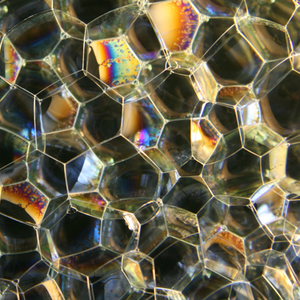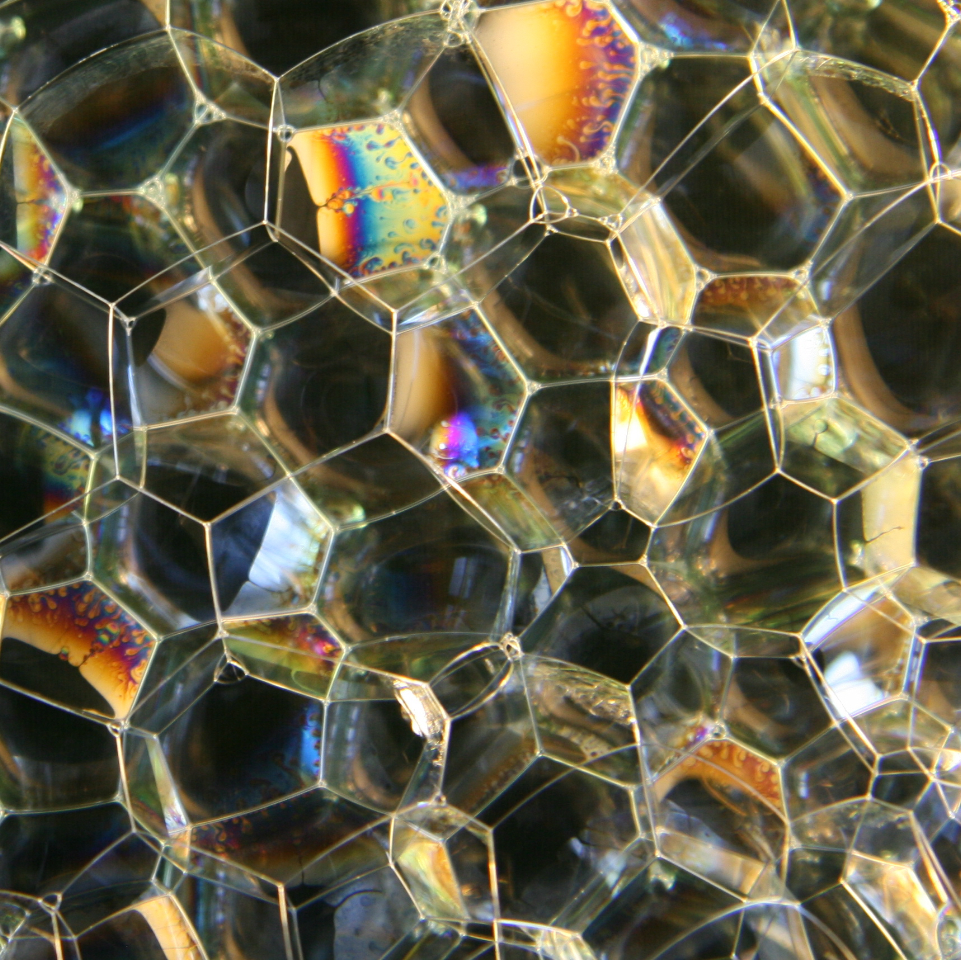Stopping Sound with Foam
While investigating the use of ultrasound to probe the structure of a liquid foam, researchers in France came across an unexpected result. In Physical Review Letters, they report that the foam completely blocked the transmission of ultrasound waves in a certain range of frequencies. Their experiments are the first demonstration that a foam can act as a metamaterial—a material whose complex internal structure endows it with unusual physical properties. The researchers suggest that such foams may have practical value as acoustic insulators.
Liquid foams are used in industry, including oil spill recovery, and as consumer products, such as shaving foam and whipped cream. The size range and distribution of bubbles in foams influence their properties and behavior, but the fragility and opacity of such foams make them hard to study. Valentin Leroy of the University of Paris-Diderot and his colleagues reasoned that measuring the transmission of sound waves through foams would be a good way to probe their structure.
The team made foams using a two-syringe method that injected air saturated with the insoluble gas perfluorohexane ( ) into water mixed with sodium dodecyl sulfate, a surfactant that stabilizes bubbles. Once a liquid foam had formed, its median bubble size grew steadily from to micrometers ( ) over a period of about minutes. Leroy and his colleagues measured the attenuation of ultrasound pulses that passed through a layer of foam sandwiched between two polymer films spaced millimeters apart. They plotted the attenuation versus bubble size and ultrasound frequency, which ranged from to kilohertz (kHz). The discovery that foam could totally block transmission came as a surprise. The range of suppressed transmission was centered at about for a median bubble size of and at about when the bubble size increased to .
An ability to block transmission in a certain frequency range was first demonstrated in 1991 for microwave radiation passing through a structure with a periodic pattern of nanosized holes (see 23 August 2013 Focus Landmark). In this periodic structure, known as a photonic crystal, interference among waves traveling different routes prevents transmission at certain frequencies. Researchers have also created similarly structured metamaterials for sound waves, but they hadn’t previously observed an acoustic metamaterial with an irregular structure, such as a foam.
Another research team recently showed that a series of thin films placed crosswise inside a tube acted as a metamaterial, strongly attenuating sound waves within a restricted frequency range [1]. To explain their own results, Leroy and his colleagues devised a model inspired by this previous work. They imagined thin flexible films stretching across a series of rigid rings, forming a stack of cells. This structure represents a column cutting through a foam—the film mimics the boundary between two bubbles, while the rings act like the liquid channels that form where several bubbles meet.
The team analyzed the passage of sound waves through this model. At the lowest frequencies, the rings and the films all move in synch with the sound waves. As the frequency rises, the heavier rings begin to lag, while the films, whose behavior is driven by their elasticity rather than their inertia, are able to keep pace. Eventually, the rings and films become so out of synch that the bulk of the mass in the model is moving with opposite phase to the sound waves, so no sound is transmitted. At higher frequencies still, the films are trying to move so fast that their inertia, not their elasticity, determines their motion. The rings and films then behave in similar ways, and sound passes again.
John Pendry of Imperial College London, who pioneered the physics of metamaterials, says that foam definitely qualifies: “A metamaterial is a material whose properties are determined through the structure rather than the composition, and a foam fulfills that very nicely.” Leroy and his colleagues plan to investigate whether more durable foams made of elastic materials will show the same behavior and will be useful for sound barriers.
–Alexander Hellemans
Alexander Hellemans is a freelance science writer in Naples, Italy, and a contributor to the upcoming book 30-Second Quantum Theory (Icon Books, June 2014).
References
- S. H. Lee, C. M. Park, Y. M. Seo, Z. G. Wang, and C. K. Kim, “Acoustic Metamaterial with Negative Density,” Phys. Lett. A 373, 4464 (2009)





